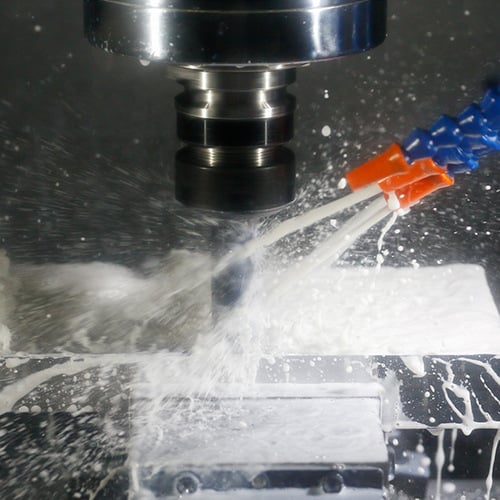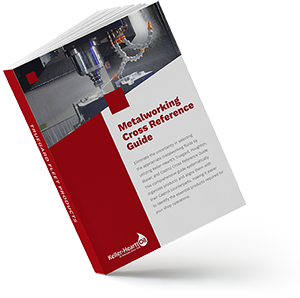
1. What types of metalworking fluids are available?
There are four main types: straight oils, soluble oils, semi-synthetic fluids, and synthetic fluids. Each type has specific properties suited to different machining operations and materials. Choosing the right fluid depends on the machining operation, the material of the workpiece, and any cooling, lubrication, or corrosion protection needs. This guide breaks down product specifications for Keller-Heartt’s line of Truegard metalworking fluids.
2. Can I use the same metalworking fluid for both ferrous and non-ferrous metals?
While some metalworking fluids work with both ferrous and non-ferrous metals, it’s generally best to choose fluids specifically formulated for the metal type. This ensures optimal performance and protection.
3. What are the benefits of using metalworking fluids?
Metalworking fluids help improve tool life, enhance surface finish, reduce heat and friction, and protect against corrosion.
4. How often should I change metalworking fluids?
This depends on the type of fluid, the machining process, and the level of contamination. Regular monitoring and maintenance can help determine optimal change intervals.
5. How can I tell that metalworking fluids need to be replaced?
Check for a decrease in performance, unpleasant odors, changes in fluid color or consistency, and any contaminants or bacterial growth.
6. How do I prevent bacterial growth in my metalworking fluid?
Maintain proper concentration levels, ensure adequate aeration, and use biocides as recommended. Regular monitoring and cleaning of the system can also help reduce bacteria.
7. Can I mix metalworking fluids with other lubricants?
It’s generally not recommended to mix metalworking fluids with other lubricants unless specified by the manufacturer. Incompatible mixtures can lead to reduced performance and possible damage to the machining system.
8. How should I store metalworking fluids?
Store metalworking fluids in a cool, dry place, away from direct sunlight and contaminants. Proper storage helps maintain fluid quality and prolongs shelf life.
9. Can metalworking fluids cause health issues?
Improper handling or prolonged exposure to metalworking fluids can cause skin irritation, respiratory issues, or other health problems. Use personal protective equipment (PPE) and follow safety guidelines to minimize risks.
10. How do I dispose of used metalworking fluids?
Follow local regulations and environmental guidelines when disposing of fluids. Some locations require fluids to be separated from other materials and delivered to approved waste facilities. It’s important to handle used fluids properly to avoid environmental contamination.
11. Can I recycle metalworking fluids?
Yes, many metalworking fluids can be recycled through filtration, centrifugation, or other methods. Recycling can reduce waste and lower operational costs.
12. What is the role of biocides in metalworking fluids?
Biocides are additives used to prevent bacterial and fungal growth in metalworking fluids. They help maintain fluid performance and extend the fluid’s life.
13. How do I maintain metalworking fluid quality?
Regularly monitor fluid concentration, pH levels, and contamination signs. Implement a routine maintenance schedule and use filtration systems to help maintain fluid quality.
14. What factors affect the performance of metalworking fluids?
Performance can be affected by fluid type, concentration, temperature, contamination, and the specific machining operation.
15. How do I measure the concentration of metalworking fluids?
You can use refractometers, titration kits, or conductivity meters to measure fluid concentration. Regular monitoring ensures the fluid is at the optimal concentration for performance.
16. What are the environmental considerations for using metalworking fluids?
Environmental considerations include proper disposal, minimizing waste, and choosing fluids with lower environmental impact. Using biodegradable or low-toxicity fluids can help reduce environmental risks.
17. What are cutting fluids and why are they important?
Cutting fluids are a type of metalworking fluid designed to lubricate and cool the cutting tool and workpiece during machining operations. They help improve tool life, surface finish, and overall machining efficiency.
18. What is semi-synthetic coolant and when should it be used?
Semi-synthetic coolant is a blend of synthetic and soluble oils, offering both cooling and lubricating properties. It is typically used in operations requiring both good cooling and lubrication, such as in CNC machining and grinding.
19. What is the best metalworking fluid for aluminum machining?
Synthetic or semi-synthetic coolants are often recommended for aluminum, due to their superior cooling and lubricating properties. These coolants can prevent material buildup on the tool, improving overall performance.
20. How do coolants differ from other metalworking fluids?
Coolants focus on reducing the heat generated during machining, while other metalworking fluids prioritize lubrication or corrosion protection. Coolants are crucial in high-speed or high-temperature operations because they help prevent overheating and extend tool/machine part life.
21. What are vanishing stamping lubricants?
Vanishing stamping lubricants are designed to evaporate or "vanish" after the stamping process, leaving no residue on the finished parts. They are ideal for applications where post-process cleaning is undesirable or unnecessary.
22. What are rust preventatives and how do they work?
Rust preventatives are coatings or additives applied to metal surfaces to protect against corrosion. They form a barrier that prevents moisture and other corrosive elements from reaching the metal.
23. How should I clean my metalworking fluid system to prevent contamination?
Periodically clean the entire system, including tanks, pipes, and nozzles. Use a system cleaner or flushing agent designed for metalworking fluid systems. Thoroughly rinse with clean water before refilling with fresh fluid.
24. How can I minimize foam in my metalworking fluid system?
Maintain proper fluid concentration, avoid excessive agitation of the fluid, and use defoamers as needed.
25. How should I handle and mix metalworking fluids to ensure safety and effectiveness?
Always follow the manufacturer's guidelines for handling and mixing metalworking fluids. Use appropriate personal protective equipment (PPE), such as gloves and eye protection. When mixing, add the concentrate to distilled water, not the other way around, to ensure proper dilution and avoid creating a hazardous mixture.
If you have more questions or need personalized advice, contact a Keller-Heartt Oil Associate. Click here to shop our metalworking fluids now.
Streamline Your Metalworking Fluid Selection Today!
Download Keller-Heartt’s Metalworking Cross Reference Guide and ensure you have the right products for peak performance in your shop.
